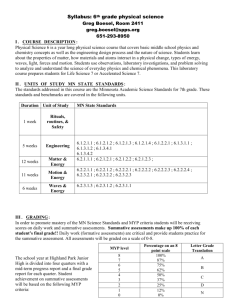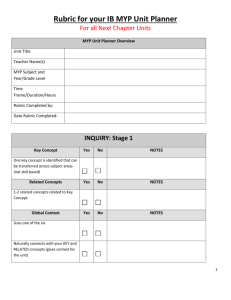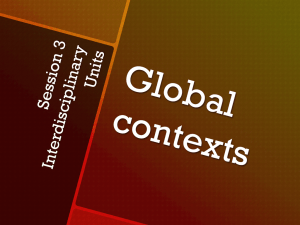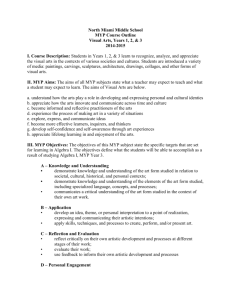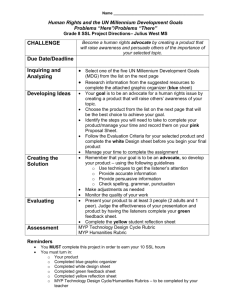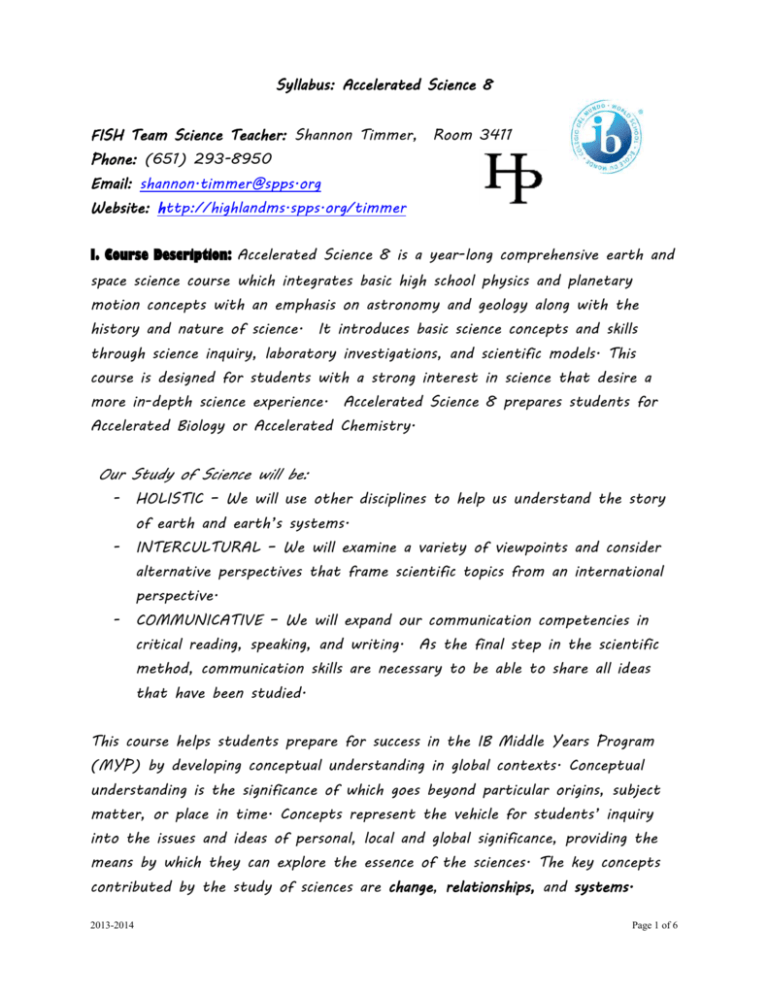
Syllabus: Accelerated Science 8
FISH Team Science Teacher: Shannon Timmer, Room 3411
Phone: (651) 293-8950
Email: shannon.timmer@spps.org
Website: http://highlandms.spps.org/timmer
I. Course Description: Accelerated Science 8 is a year-long comprehensive earth and
space science course which integrates basic high school physics and planetary
motion concepts with an emphasis on astronomy and geology along with the
history and nature of science. It introduces basic science concepts and skills
through science inquiry, laboratory investigations, and scientific models. This
course is designed for students with a strong interest in science that desire a
more in-depth science experience. Accelerated Science 8 prepares students for
Accelerated Biology or Accelerated Chemistry.
Our Study of Science will be:
-
HOLISTIC – We will use other disciplines to help us understand the story
of earth and earth’s systems.
-
INTERCULTURAL – We will examine a variety of viewpoints and consider
alternative perspectives that frame scientific topics from an international
perspective.
-
COMMUNICATIVE – We will expand our communication competencies in
critical reading, speaking, and writing. As the final step in the scientific
method, communication skills are necessary to be able to share all ideas
that have been studied.
This course helps students prepare for success in the IB Middle Years Program
(MYP) by developing conceptual understanding in global contexts. Conceptual
understanding is the significance of which goes beyond particular origins, subject
matter, or place in time. Concepts represent the vehicle for students’ inquiry
into the issues and ideas of personal, local and global significance, providing the
means by which they can explore the essence of the sciences. The key concepts
contributed by the study of sciences are change, relationships, and systems.
2013-2014
Page 1 of 6
The study of science is a natural laboratory for developing in students’ identity
and habits of mind that support the IB LEARNER PROFILE. Throughout the
year we learn using real world problems, inquiry lab experiments, analysis of
scientific data. Scientific notebooks will be used as a record of learning as
students become inquirers, knowledgeable, thinkers, communicators, principled,
open minded, risk-takers, balanced, caring, and reflective.
II. Units of Study:
1) Nature of Science/Engineering- How do I as a scientist discover new things
and share what I find?
Topics covered: Scientific method, engineering
2) Matter – What is everything made of?
Topics covered: Atoms, molecules, density
3) Rocks and Minerals – What makes up the world around me?
Topics covered: Identifying and types of rocks and minerals
4) Earth Structures & Processes – How does the Earth work?
Topics covered: Plate tectonics, earthquakes, volcanoes, tsunamis, and
mountains
5) Astronomy – What is out there?
Topics covered: Planets, moons, stars, universe, and seasons
6) Forces & Motion – How do things move?
Topics covered: Inertia, gravity, Newton’s laws, calculating forces
7) Energy – How does change happen?
Topics covered: Types of energy, energy transformation, work, power,
electricity, and magnetism
III. Global Contexts:
Each science unit will be approached using a particular focus called Global
Contexts: Identities and relationships, Orientation in time and space, Personal
and cultural expression, Scientific and technical innovation, Globalization and
sustainability, and Fairness and development.
IV. Texts:
Primary Text = Science Explorer: Earth Science, Pearson/Prentice Hall, 2009
Science Explorer: Motion, Forces and Energy, Pearson/Prentice Hall, 2009
2013-2014
Page 2 of 6
Science Explorer: Electricity and Magnetism, Pearson/Prentice Hall, 2009
Science Explorer: Chemical Building Blocks, Pearson/Prentice Hall, 2009
Students will check out the Earth Science book from the library to bring home
and leave at home.
Please visit https://highlandms.spps.org/textbook to sign up for the online
textbooks.
V. Methodology:
In the MYP science instruction, a variety of media will be used to access
information with a focus on inquiry methods and collaborative group work. This
will allow students to utilize the Approaches to Learning in science. MYP
Approaches to Learning include: organizational skills, collaborative skills,
communication, information literacy, reflection, problem solving and thinking
skills, science-specific and interdisciplinary understanding.
VI. Methods of Assessment:
Students are assessed on a set of MYP criteria and state standards. The success
of the student is measured and communicated as Levels of Achievement, which is
outlined in rubric format. A heavier emphasis is placed upon SUMMATIVE
ASSESSMENTS such as projects, tests, quizzes, and lab investigations resulting
in 100% of the final grade. FORMATIVE ASSESSMENTS, including homework,
daily work, lab activities, etc., are used to help students and teachers gauge
where students are at in the learning process as they prepare to apply their
leaning on the summative assessments. While formative assessments are not
factored into the final grade, they are the pathways to success on the
summative assessments.**
Grading and Reporting:
The school year at Highland Park Junior High is divided into four grading periods,
or quarters, with a mid-term progress report and a final grade report for each
quarter. Each criterion is separated into 8 levels of achievement, which equate
to a non-traditional percentage and letter grade. Student achievement on
summative assessments will be based on the following MYP criteria:
2013-2014
Page 3 of 6
MYP Objectives/Criteria*:
A: Knowing and understanding – Students develop scientific knowledge and apply
it to solve problems and express scientifically supported judgments.
B: Inquiring and designing – Intellectual and practical skills are developed through
designing and performing scientific investigations.
C: Processing and evaluating – Students collect, process and interpret qualitative
and/or quantitative data, and explain conclusions that have been appropriately
reached.
D: Reflecting on the impacts of science – Students gain global understanding of
science by evaluating the implications of scientific developments and their
applications to a specific problem or issue.
*A minimum of two of each criterion will be assessed each year. The student’s final grade will
be determined by the results of their summative assessments (100% of their grade).
**Please see the HPMS Assessment Policy at
https://highlandms.spps.org/preview_our_assessment_policy.html
2013-2014
for further information.
Page 4 of 6
State Science Standards and Power benchmarks
The Nature of Science and Engineering Standards
The Practice of Science:
(8.1.1.1) The student will understand that science is a way of
knowing about the natural world and is characterized by
empirical data, logical argument, and skeptical review.
(8.1.1.2) The student will understand that scientific inquiry
uses multiple interrelated processes to investigate questions
and propose explanations about the natural world.
Interactions among Science, Technology, Engineering,
Math and Society:
(8.1.3.2) The student will understand that men and
women throughout the history of all cultures, including
Minnesota American Indian tribes and communities, have
been involved in engineering design and scientific inquiry.
(8.1.3.3) The student will understand that science and
engineering operate in the context of society and both
MYP Science Aims and Objectives
Develop inquiring minds and
curiosity about science and the
natural world
Acquire knowledge, conceptual
understanding and skills to solve
problems and make informed
decisions in scientific and other
contexts
Develop skills of scientific inquiry
to design and carry out scientific
investigations and evaluate
scientific evidence to draw
conclusions
influence and are influenced by this context.
(8.1.3.4) The student will understand that current and Communicate scientific ideas,
arguments and practical
emerging technologies have enabled humans to develop
and use models to understand and communicate how
experiences accurately in a variety
natural and designed systems work and interact.
of ways
Matter:
Think analytically, critically, and
(8.2.1.1) The student will understand that pure substances
creatively to solve problems,
can be identified by properties which are independent of the
judge arguments and make
Physical Science 8 Standards
2013-2014
Page 5 of 6
sample of the substance and the properties can be explained
decisions in scientific and other
by a model of matter that is composed of small particles.
contexts
(8.2.1.2) The student will understand that substances can
undergo physical and / or chemical changes which may change
the properties of the substance but do not change the total
mass in a closed system.
Energy:
(8.2.3.1) The student will understand that waves involve
the transfer of energy without the transfer of matter.
Appreciate the benefits and
limitations of science and its
application in technological
developments
Earth and Space Science Standards
Understand the international
Earth Structure and Processes:
nature of science and the
(8.3.1.1) The student will understand that the movement
interdependence of science,
of tectonic plates results form interactions among the
technology and society, including
lithosphere, mantle and core.
the benefits, limitations and
(8.3.1.2) The student will understand that landforms are
implications imposed by social,
the result of the combination of constructive and destructive
processes.
(8.3.1.3) The student will understand that rocks and rock
formations indicate evidence of the materials and conditions
that produced them.
The Universe:
(8.3.3.1) The student will understand that the Earth if the
third planet from the sun in a system that includes the
economic, political, environmental,
cultural and ethical factors
Demonstrate attitudes and
develop values of honesty and
respect for themselves, others,
and their shared environment
moon, the sun, seven other planets and their moons, and
smaller objects.
Physical Science 9 Standards
** We will address MYP Science
Forces & Motion:
Objectives through each state
(9.2.2.2) The student will understand that an object’s mass content standarda: Knowing and
and the forces on it affect the motion of an object.
understanding, Inquiring and
Energy:
(9.2.3.2) The student will understand that energy can be
transformed within a system or transferred to other systems
or the environment, but is always conserved.
designing, Processing and
evaluating, and Reflecting on the
impacts of science.
For a description of these objectives,
see section VI of this syllabus
(Grading and Reporting).
2013-2014
Page 6 of 6

